
Figure 1. Microscope slides that were made (or owned) by J.P. Tylee. He was a member of the Bath Microscopical Society (B.M.S.), - see Figure 3.
John Palmer Tylee, 1801 - 1876
J. P. T.
by Brian Stevenson
last updated February, 2021
J.P. Tylee was a founder and long-time member of the Bath (England) Microscopical Society (B.M.S.), and served as the group's Librarian for many years. He worked as a pharmaceutical chemist, and probably learned about microscopes during his training, as it was important for pharmacists to accurately identify botanicals and other substances used as medicines.
Tylee's microscope slides are seen with some frequency, some with custom-printed labels bearing his initials, and others with his handwritten name (Figures 1 and 2).
Many also have labels from the B.M.S. These might indicate donations to the Society, labels made available by the Society for member's personal use, or because these slides were exhibited at microscopical soirees, where large numbers of microscopes and specimens would be on public display. These labels would keep track of each exhibitor's slides, as well as identify exhibitors for the visitors and thereby stimulate discussion. Bath Microscopical Society records describe public exhibitions with many dozens of microscopes with specimens.

Figure 1.
Microscope slides that were made (or owned) by J.P. Tylee. He was a member of the Bath Microscopical Society (B.M.S.), - see Figure 3.
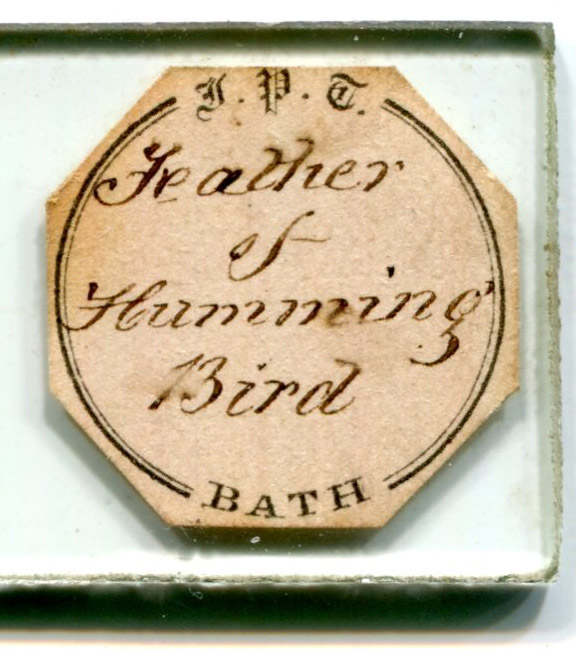
Figure 2.
Enlargement of Tylee’s custom-printed "J.P.T." label.

Figure 3.
1870 officers and other information on the Bath Microscopical Society. J.P. Tylee was then the Society's Librarian. From "The Medical Directory".
John Palmer Tylee was born on May 23, 1801, in Bath. His father, Henry Dixon Tylee, was a well-known musician, music teacher, and organist of Bath Abbey. Palmer was the maiden name of his mother, Mary.
An 1824 trade directory listed "Tylee, chemist and druggist, London-street, Walcot", which may have been J.P. Tylee. The directory also included "Scott, R. chemist and druggist, 7, Bridge-street", with whom Tylee later formed a partnership. That partnership, "Scott, Robert, and John Palmer Tylee, Bridge-street, Bath, chemists and druggists" ended in 1831, with Tylee retaining the Bridge Street shop. Some advertisements from that address are shown in Figures 4-7.
Tylee married Mary Perry on December 2, 1824, at Bath Abbey. They had at least four children, two boys and two girls. Both boys and at least one of the girls later emigrated to Australia and New Zealand.
The city of Bath is famous for its mineral springs, and people have long travelled there to soak in the waters, which were thought to have healing properties. During the 1800s, batteries and other electrical apparatus became widely-available, leading to numerous investigations into the potential medical uses of electricity. J.P. Tylee developed a combination of the two "therapies", which he described in his ca. 1848 book, Practical Observations on Galvanism, Electricity, and Electro-Magnetism, as Employed in the Cure of Disease: with Remarks on the Advantage of Their Application through the Medium of Baths. The following is a review from The Chemist, "The object of this work is to prove the superiority of the plan of administering electricity by means of baths, as proposed by Mr. Tylee, and he gives the following 'especial reasons' for preferring it: 'First, because it differs from the usual mode in not producing violent and oft-repeated shocks; in the water its flow is continuous, and is a current rather than a shock. While the dry electro-galvanism influences more particularly the courses of the particular nerves and their primary branches, the water medium enables us to apply this powerful agent to the more sentient extremities, so that the minutest fibres of a muscle, or set of muscles, are brought into a pleasurable action rather than into a spasmodic one. By means of a portable disc we are enabled to produce this effect at will, to regulate the intensity of the current, and, by its modification, to apply it to any distinct set of muscles, without implicating those which are unaffected by disease, which is not the case with dry electro-galvanism; I conceive its supplication to be most useful in the various cases in which the lumbar muscles, or those of an entire limb, are deficient in nervous powers or energy. In eye cases this method is more likely to be successful than the vibrating shock of the usual method, for the application of which I have invented an eye bath, so that the intensity can be regulated with the nicety required for so delicate an organ. It must be remembered that natural and artificial warm baths are means of cure in almost every case in which the application of electro-galvanism is required, so that, by its combination with the warm bath, we are using two agents combined in a useful and agreeable manner'. He gives some cases in which he has found advantage from this mode of applying galvanism. We recommend the subject to the attention of our readers". An 1870 directory of Bath listed Tylee under both "Chemists and Druggists" and "Medical Galvanist" (his was the only entry under the second category).
Tylee also became proficient in applying ether as an anesthetic. He provided that service for Bath's first tooth extractions under anesthesia, in January, 1847. The dentist, James Edwards, then advertised, "Mr. Edwards having extracted a great number of teeth without pain to the patient, by the novel mode of inhaling ethereal vapour under the superintendence of Mr. Tylee, Chemist, Bridge Street, he now announces that he has arranged with the gentleman to administer it in any case where that invaluable sedative may be required".
In 1858, J.P. Tylee and colleagues founded the Bath Microscopical Society, (Figure 3).
Around 1876, Tylee formed a partnership with Henry Hillier (Figure 7). Hillier continued the pharmacy business as "Tylee and Hillier" after Tylee's death. By the mid-1880s, the shop had transferred to Harold Boutell, operating as "Tylee and Boutell", then "Tylee & Company". In 1890, ownership transferred to Harry Hutton, who retained the business name of "Tylee & Co.". Clearly, J.P. Tylee's name had considerable value in the Bath pharmaceutical trade.
Tylee died on October 10, 1876. His obituary in The Pharmaceutical Journal and Transactions read, "Another old friend of the Pharmaceutical Society has passed away in Mr. John Palmer Tylee, Pharmaceutical Chemist, of Bridge Street, Bath, who died at an advanced age on the 10th inst. In 1841 the first meeting of the chemists and druggists of Bath in support of the newly formed Pharmaceutical Society of Great Britain was held in Mr. Tylee's house, and he was elected local secretary, the duties of which office be discharged so well for twenty years, that when he resigned a suitable testimonial was presented to him by the Bath members. At the time of the visit of the British Pharmaceutical Conference to Bath, in 1864, Mr. Tylee was President of the Bath Chemists and Druggists' Association. A local newspaper says of him: 'As one of the founders of the Bath Microscopical Society, and ever an active and valuable member, Mr. Tylee will long be remembered for his generous disposition and constant willingness to help forward all younger students. A man of keen perception and marked sagacity, he was diffident to a fault, and through taking little share in public life, his loss in this respect will be less regarded. The genuine character of the man, and the singular simplicity of his life, will embalm his memory among all who knew him'."
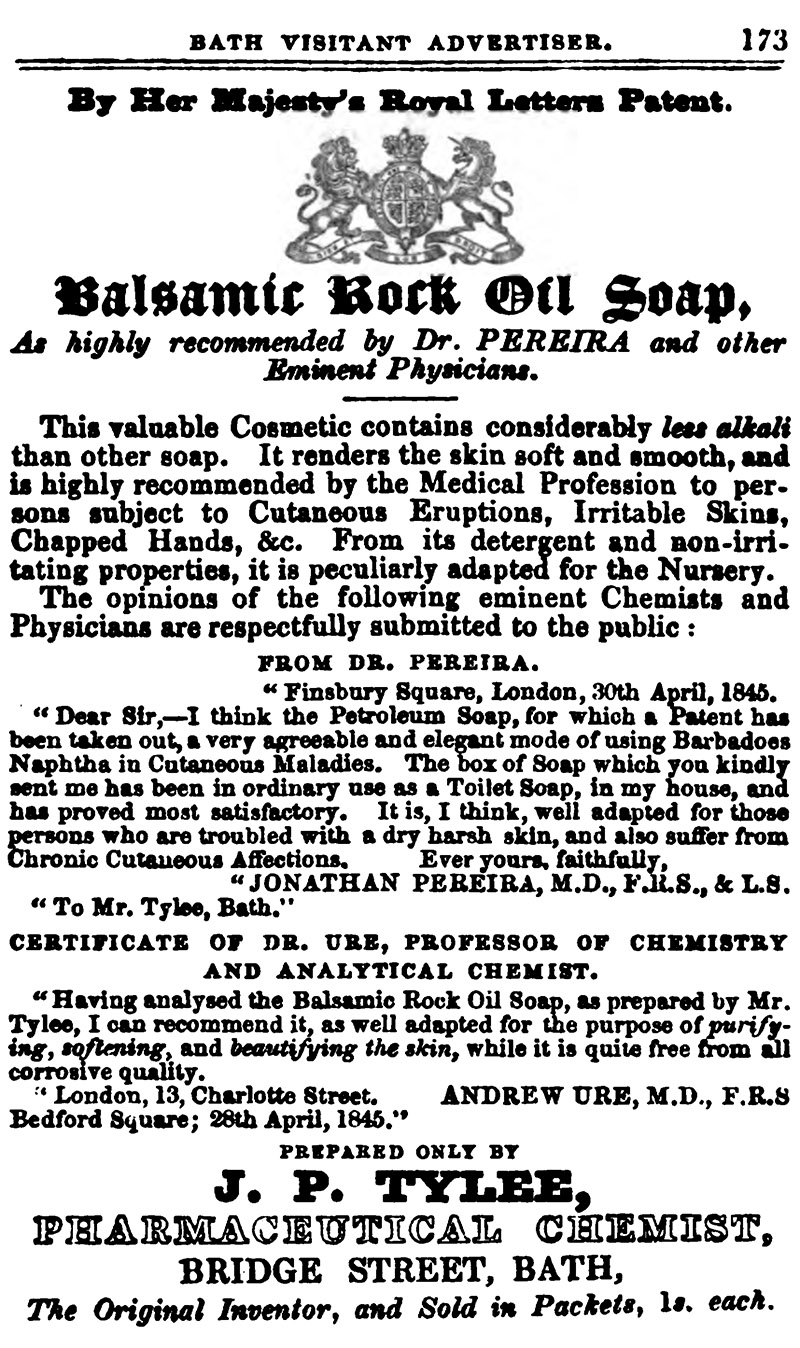
Figure 4.
An 1845 advertisement from John Palmer Tylee.
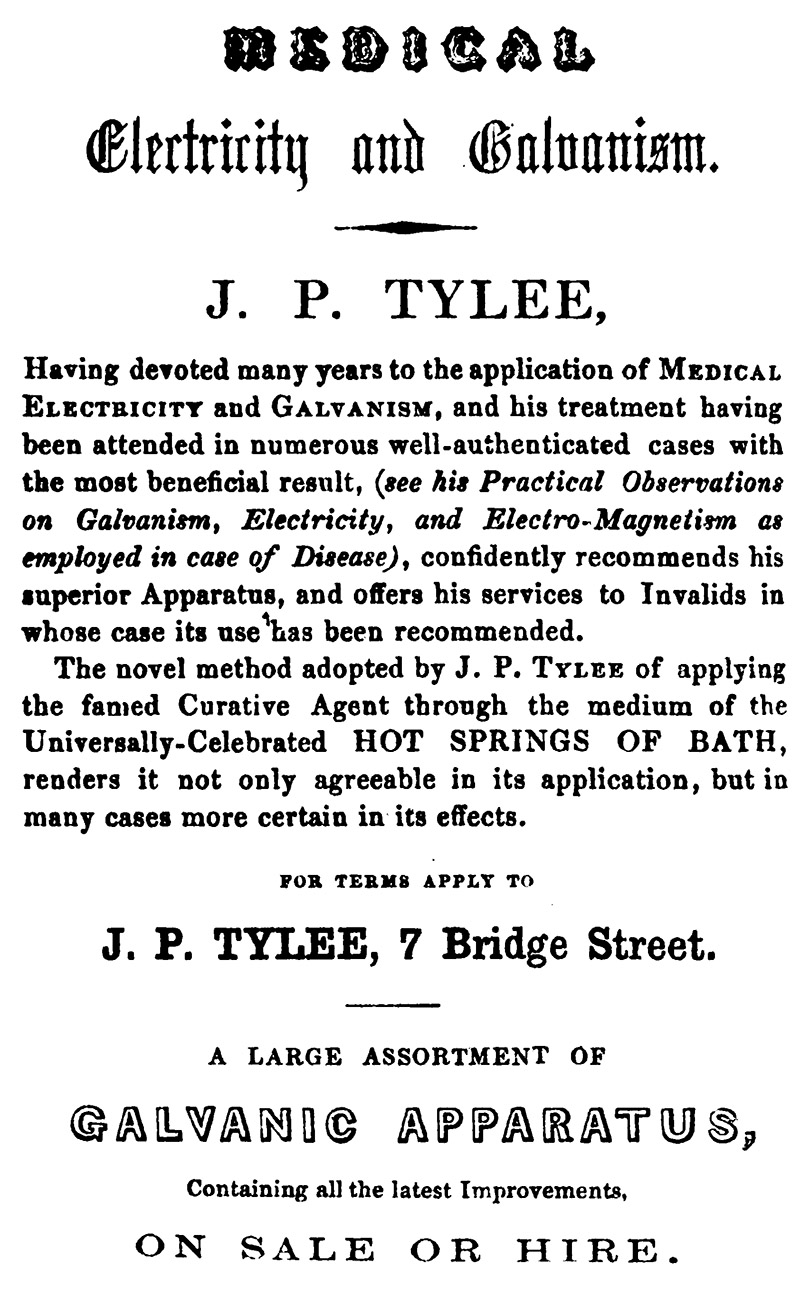
Figure 5.
Another 1845 advertisement from J.P. Tylee, regarding his novel combination of electricity and mineral water baths.
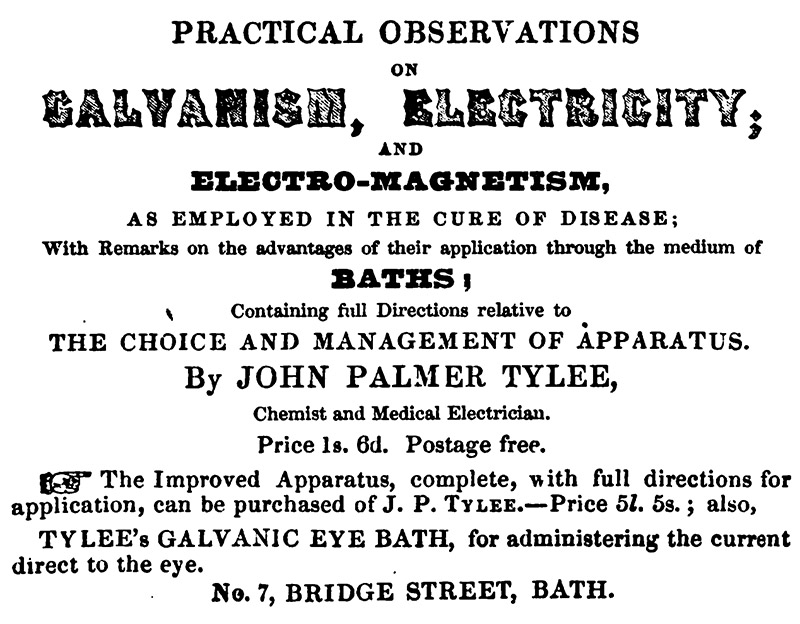
Figure 6.
An 1849 advertisement for Tylee’s book, "Practical Observations on Galvanism, Electricity, and Electro-Magnetism, as Employed in the Cure of Disease: with Remarks on the Advantage of Their Application through the Medium of Baths".
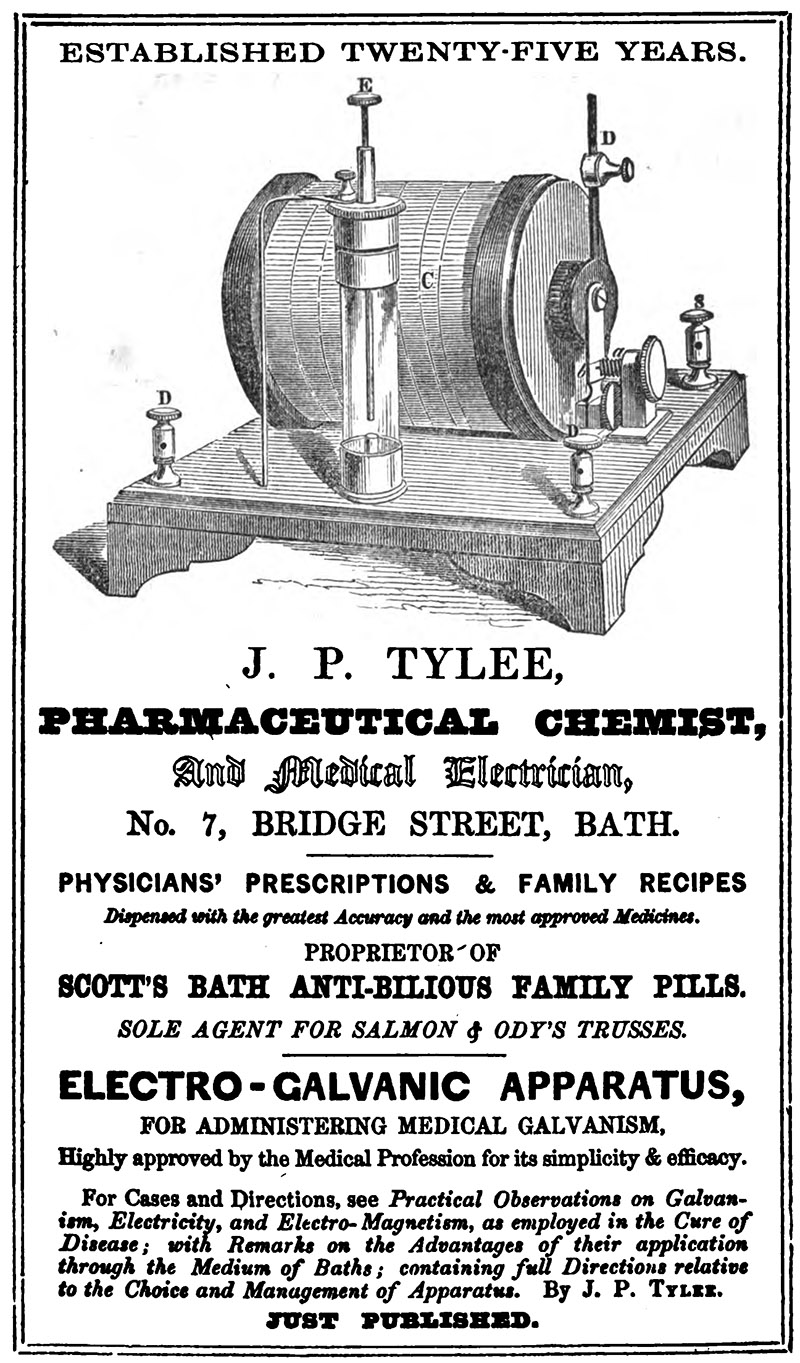
Figure 7.
An 1850 advertisement.
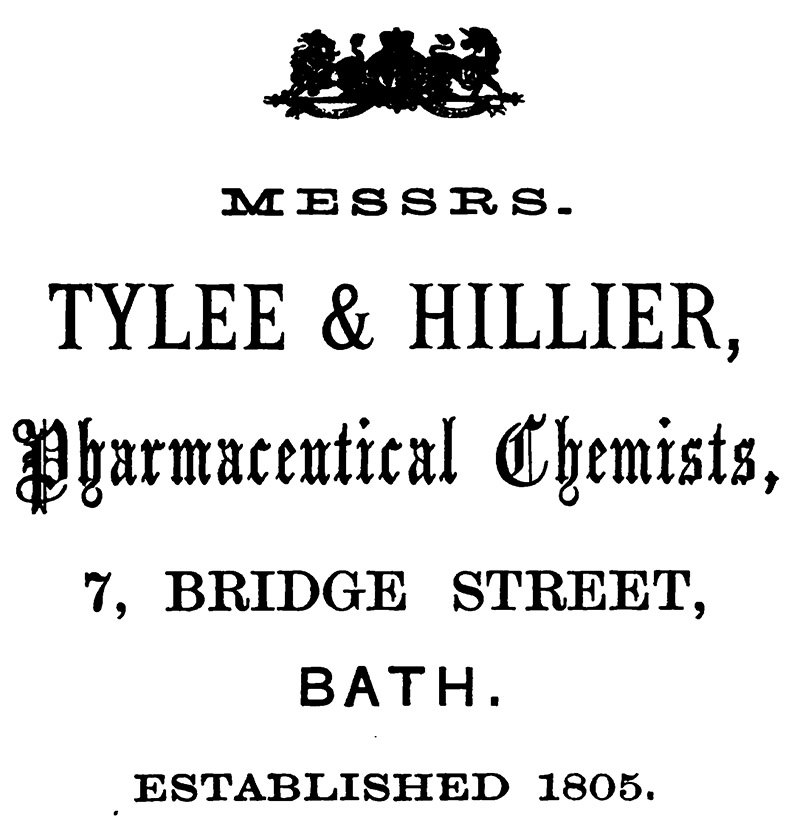
Figure 8.
An 1876 advertisement, from around the time of J.P. Tylee’s death. The noted date of establishment, 1805, may represent the year that Tylee's former partner, Robert Scott, founded the pharmacy on Bridge Street.
Resources
Bath Annual Directory(1850) Advertisement from J.P. Tylee, C. Clark, Bath
The Chemical Directory, and Pharmaceutists' Compendium (1852) Advertisement from J.P. Tylee
The Chemist (1849) Review of Practical Observations on Galvanism, Electricity, and Electro-Magnetism, as Employed in the Cure of Disease: with Remarks on the Advantage of Their Application through the Medium of Baths, Vol. 1, page 142
Chemist and Druggist (1887) "Chlorophosphate ; for a medical preparation. By Harold Boutell, chemist (trading as Tylee & Co.), Bath", page 20
England census and other records, accessed through ancestry.com
Gibbs's illustrated Bath Visitant (1845) Advertisements from J.P. Tylee
Hunt's, Late Gye's, Original Bath Directory (1824) pages 90 and 98
Kelly's Directory of Chemists and Druggists (1885) "Tylee & Boutelle, 7 Bridge St.", page 152
The Law Advertiser (1831) Partnerships dissolved, Vol. 9, page 336
London Gazette (1890) Dissolution of the partnership between H. Boutell and Harry Hutton, page 7074
Marjot, R. (2009) The first anaesthetics in Bath, Proceedings of the History of Anaesthesia Society, Vol. 41, pages 9-18
Marriage record of John Palmer Tylee and Mary Perry (1824) records of Bath Abbey, accessed through ancestry.com
The Medical Directory (1870) Bath Microscopical Society, page 665
The Medical Directory (1873) Bath Microscopical Society, page 705
The Pharmaceutical Journal and Transactions (1876) John Palmer Tylee, page 347
The Post Office Directory of Chemists and Druggists (1870) page 210
Probate of the Will of J.P. Tylee (1876) "The Will of John Palmer Tylee late of 17 New-King-street in the City of Bath Chemist and Druggist who died 10 October 1876 at 17 New-King-street was proved at Bristol by Mary Tylee of 17 New-King-street the Relict the surviving Executor. Effects under £1,500", accessed through ancestry.com
Tunstall, James (1850) The Bath Waters: Their Uses and Effects in the Cure and Relief of Chronic Diseases, J. Churchill, London, pages 131-135
Tunstall, James (1876) Rambles About Bath and Its Neighbourhood, Simpkin, Marshall, and Company, Bath, contains advertisement from Tylee and Hillier
Wikitree (accessed February, 2021) https://www.wikitree.com/wiki/Tylee-31
Yearbook of Pharmacy (1877) "Hillier Mr. H., 7 Bridge Street, Bath", page 367